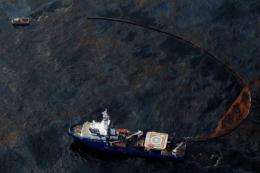A boat uses a protective boom to collect oil leaking from the Deepwater Horizon wellhead in the Gulf of Mexico. A giant oil slick threatened Thursday to pollute the fragile wetlands of Louisiana, as officials warned that toxic crude was pouring into the Gulf of Mexico five times faster than previously thought.
Offshore winds pushed a giant oil slick closer to the Louisiana coast Thursday amid a frenzied effort by authorities to contain what one official said had become a disaster of "national significance."
The White House pledged "all available resources," including the military, to avoid an environmental catastrophe, and the Defense Department said it was studying ways to help as officials revealed that the Gulf of Mexico oil spill was far worse than believed.
Louisiana Governor Bobby Jindal declared a state of emergency amid forecasts that parts of the oil slick may reach parts of the Louisiana coastline later Thursday.
"It is a question of when, not if, the oil is going to come on shore," Doug Helton, incident operations coordinator for the National Oceanographic and Atmospheric Administration, told AFP.
The governor's pronouncement listed at least 10 wildlife refuges in Louisiana and Mississippi that are in the direct path of the oil and that are likely to be impacted, adding that "billions of dollars in ongoing coastal restoration projects may be at risk because of this emergency."
A massive deployment of resources and manpower so far "has not slowed the diffusion of the oil, which has reached over a 600-square mile (1,500 square kilometer) area and is about 16 miles (25 kilometers) off the Louisiana coast."
NOAA's Helton added that offshore conditions "are going to be increasingly difficult" because high waves will make it harder to contain the oil.
The presence of the giant slick, now said to be growing five times faster then previously thought, off Louisiana's ecologically vulnerable shores dominated a White House press briefing Thursday.
"We will use all available resources, possibly including those at the Department of Defense," White House spokesman Robert Gibbs told reporters.
Homeland Security Secretary Janet Napolitano said the decision to designate the slick a disaster of "national significance" would allow cleanup equipment and resources from across the United States to be used.
Geoff Morrell, a Pentagon spokesman, said the military was "in the process of determining what if any help we could provide" but added that "we have come to no conclusion yet."
The increased government urgency followed the discovery of a new leak that officials said meant a fivefold increase in the amount of oil, to 5,000 barrels or more than 200,000 gallons a day, pouring out from the debris of a sunken rig.
If large quantities of crude drift into Louisiana's marshy wetlands, which are a complex series of watery channels only navigable by boat, mopping up would be next to impossible.
It would be disastrous for natural parks full of waterfowl and rare wildlife and could also imperil the state's 2.4-billion-dollar-a-year fisheries industry, which produces a significant portion of US seafood.
As Jindal called for miles more protective booms to guard parks and fisheries in his southern state, weather experts predicted horrible weather all weekend that could seriously hamper emergency response efforts.
Crews conducted a controlled "trial" burn Wednesday of one of the thickest parts of the slick, but heavier winds and high seas forecast through the weekend meant such operations were suspended indefinitely.
Oil continued to gush out from near the Deepwater Horizon platform, which sank April 22, two days after a huge explosion that killed 11 workers.
The accident has not disrupted offshore energy operations in the Gulf, which account for 30 percent of all US oil production and 11 percent of domestic gas production.
British energy giant BP, which leased the semi-submersible rig from Houston-based contractor Transocean, has been operating four robotic submarines to try and cap the ruptured well on the seabed some 5,000 feet (1,500 meters) below the surface.
Crews have failed so far to fully activate a giant 450-tonne valve system, called a blowout preventer, that should have shut off the oil as soon as the disaster happened.
As a back-up, engineers were constructing a giant dome that could be placed over the leaks to trap the oil, allowing it to be pumped up to container ships on the surface.
Should the latest figures for the spill be accurate, nearly 1.5 million gallons of crude have already spewed into the Gulf.
By comparison, some 11 million gallons of crude spilled from the Exxon Valdez into Prince William Sound, Alaska in 1989.
Two Louisiana shrimpers, meanwhile, filed a lawsuit accusing the operators of the rig of negligence, seeking millions of dollars in damages.
The shrimpers are seeking class-action status on behalf of "all Louisiana residents who live or work in, or derive income from," the Louisiana coastal zone, and who have sustained damages as a result of the oil spill.
(c) 2010 AFP






















